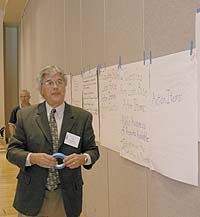| Jim Goodwin of the WRDC looks over the issue detail charts from session one. |
Thursday was a day for people from around the eastern and southeastern Utah region to gather their thoughts on the problems that concern the area and put those ideas to the paper.
It all happened at a meeting of the Western Rural Policy Advocates rural policy forum held on the College of Eastern Utah campus.
All in all, 55 people attended the forum to voice their minds on what it will take to make eastern Utah the best it can be.
The forum was sponsored by the Western Rural Development Center from Utah State University, the Center for Rural Affairs based in Lyons, Neb. and the Rural Community Assistance Corporation from Oregon.
The WRDC will be holding a number of such meetings around Utah over the next few months. The idea of the forums is to gather ideas on what issues are important to rural society and economies.
“What we are looking for from you, are two or three main ideas that are the most important,” said Jim Goodwin of the WRDC as he addressed the gathered group. “There are many, many issues out there, and if we try to present them all at the state legislative level the will not be addressed properly. We need specifics.”
| Kim Leval addresses the group with a national perspective. |
When all the meetings in the state are concluded, then the WRDC will be having a “Summit” to review all the different ideas that have been gathered and pick two to three that will have voice with lawmakers.
“They may all be good ideas,” said Goodwin. “But we need a few that can be specifically addressed. We need a unified voice on three tor four issues.”
The program began with introductions and then a panel discussion involving local state legislative representative Brad King, San Juan county clerk/auditor, Norman Johnson, Kim Leval from the Center for Rural Affairs, Chris Marko and Dave Conine from the Rural Community Assistance Corporation.
“Rural solutions will never come from Salt Lake,” King told the gathering. “They must come from us. Take Highway 6 for example. It is always the second most important project on most legislators mind, with the first being something of importance in their area. We are the ones that must come up with the answers.”
Johnson said that he saw transportation, communication infrastructure and natural resources as being the most important issues of our time in the region.
“Let me give you an example,” he said. “When they had the Red Bull air races in San Juan county this spring, the participants found out that cell phone service was spotty in the area. They had a temporary cellular tower erected so that they could communicate. They saw the problem and corrected it. It can be done.”
Leval, who is an expert on rural political action told the group that issues from rural areas need to be framed in positive terms when talking with elected officials.
“When you have an issue you want to get across, put it in a way that you are for something, not against something else,” she said. “We also need to measure our progress by the small successes we have along the way and not by the final goal.”
| The groups meet to hammer out issues and how to get solutions to problems confronting the area. |
Oregon has been successful with the type of program that is being organized in Utah, pointed out Marko.
“First of all you need the state legislators to participate in these kinds of forums and people need to follow up and build those relationships,” he stated. “This past year three of the five policy issue we had gathered from around the state moved ahead this year because of our concentration and the solid support of rural people. And when we do this type of thing we need to ask ourselves “How real are these issues at the local level?”
Once the panel was over, the group broke into study groups to come up with issues that they thought were important. People in the room were asked to sit and work with people who they didn’t know well or had not worked with in a long time. Each group had a leader and the scribe who wrote the ideas down on poster paper. When the first session ended all the ideas and issues were placed on the walls around the room and the leaders were asked to explain their groups concepts.
Amazingly enough the tone of the groups were similar with infrastructure (communications, electrical and other services), education, transportation and economic development being the main topics on all the posters in one way or another.
But the topics were still very broad and second session was used to take each of the major topics and then have another group of people work on concepts of how to affect those issues in future dealings with state and federal elected officials. In other words the groups were to come up with a road map of how to get from point A to point B in terms of solving problems.
The day ended a success with the beginning concepts being defined more closely and good ideas to affect them coming from the assembled minds.
In the end concepts about infrastructure, education and transportation won the day and those ideas will be forwarded to the summit when it occurs.

